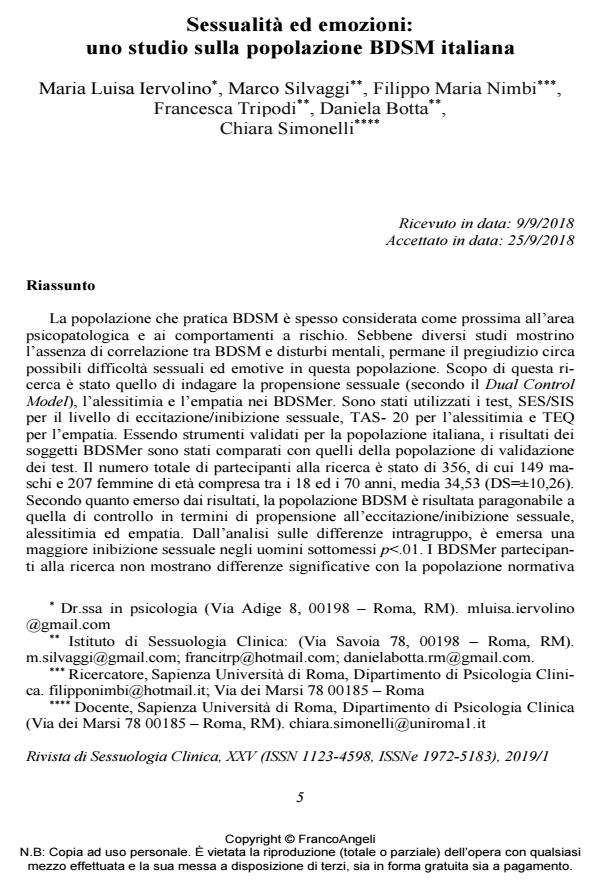Sessualità ed emozioni: uno studio sulla popolazione BDSM italiana
Titolo Rivista RIVISTA DI SESSUOLOGIA CLINICA
Autori/Curatori Maria Luisa Iervolino, Marco Silvaggi, Filippo Maria Nimbi, Francesca Tripodi, Daniela Botta, Chiara Simonelli
Anno di pubblicazione 2019 Fascicolo 2019/1
Lingua Italiano Numero pagine 26 P. 5-30 Dimensione file 403 KB
DOI 10.3280/RSC2019-001001
Il DOI è il codice a barre della proprietà intellettuale: per saperne di più
clicca qui
Qui sotto puoi vedere in anteprima la prima pagina di questo articolo.
Se questo articolo ti interessa, lo puoi acquistare (e scaricare in formato pdf) seguendo le facili indicazioni per acquistare il download credit. Acquista Download Credits per scaricare questo Articolo in formato PDF

FrancoAngeli è membro della Publishers International Linking Association, Inc (PILA)associazione indipendente e non profit per facilitare (attraverso i servizi tecnologici implementati da CrossRef.org) l’accesso degli studiosi ai contenuti digitali nelle pubblicazioni professionali e scientifiche
La popolazione che pratica BDSM è spesso considerata come prossima all’area psicopatologica e ai comportamenti a rischio. Sebbene diversi studi mo-strino l’assenza di correlazione tra BDSM e disturbi mentali, permane il pregiudizio circa possibili difficoltà sessuali ed emotive in questa popolazione. Scopo di questa ricerca è stato quello di indagare la propensione sessuale (secondo il Dual Control Model), l’alessitimia e l’empatia nei BDSMer. Sono stati utilizzati i test, SES/SIS per il livello di eccitazione/inibizione sessuale, TAS- 20 per l’alessitimia e TEQ per l’empatia. Essendo strumenti validati per la popolazione italiana, i risultati dei sog-getti BDSMer sono stati comparati con quelli della popolazione di validazione dei test. Il numero totale di partecipanti alla ricerca è stato di 356, di cui 149 maschi e 207 femmine di età compresa tra i 18 ed i 70 anni, media 34,53 (DS=±10,26). Se-condo quanto emerso dai risultati, la popolazione BDSM è risultata paragonabile a quella di controllo in termini di propensione all’eccita¬zio¬ne/inibizione sessuale, alessitimia ed empatia. Dall’analisi sulle differenze intragruppo, è emersa una maggiore inibizione sessuale negli uomini sottomessi p<.01. I BDSMer partecipanti alla ricerca non mostrano differenze significative con la popolazione normativa rispetto alla propensione all’eccita¬zio¬ne/inibizione sessuale, alla capacità di rico-noscere ed esprimere le emozioni e all’empatia. La maggiore tendenza all’inibizione sessuale da parte dei soggetti maschi con ruolo di sottomessi, può es-sere spiegata dal fatto che, culturalmente, la sottomissione risulta incompatibile con l’identità sessuale maschile stereotipica.
Parole chiave:BDSM, emozioni, sadomasochismo, empatia, alessitimia.
Maria Luisa Iervolino, Marco Silvaggi, Filippo Maria Nimbi, Francesca Tripodi, Daniela Botta, Chiara Simonelli, Sessualità ed emozioni: uno studio sulla popolazione BDSM italiana in "RIVISTA DI SESSUOLOGIA CLINICA" 1/2019, pp 5-30, DOI: 10.3280/RSC2019-001001